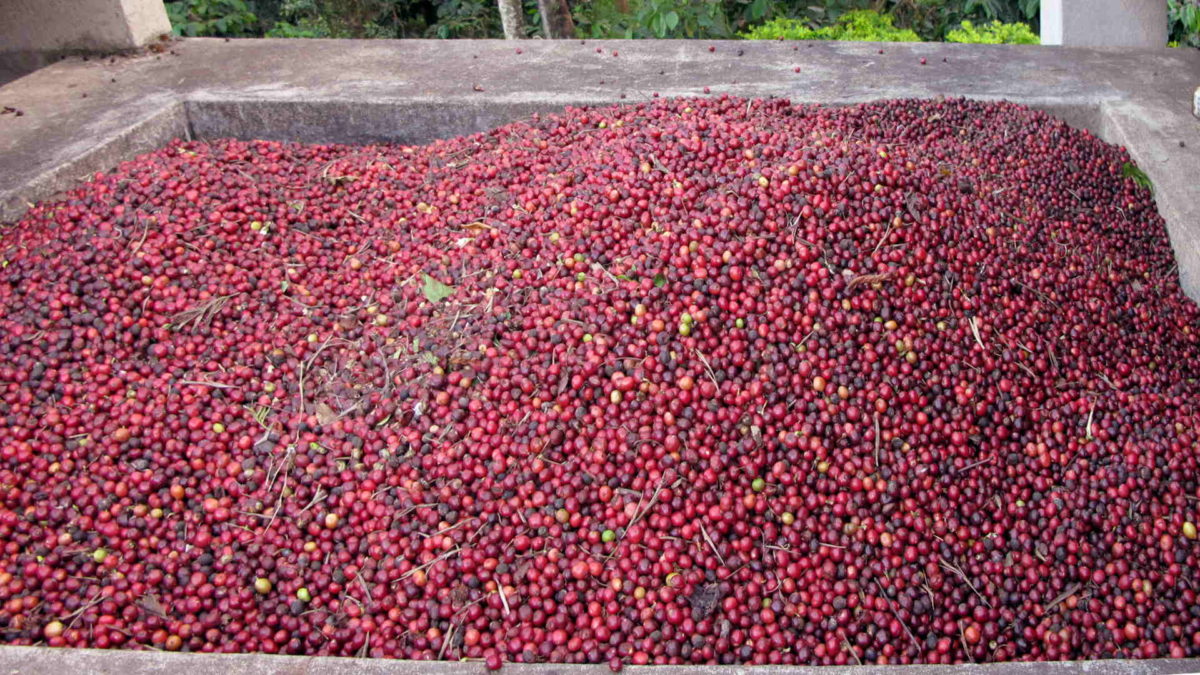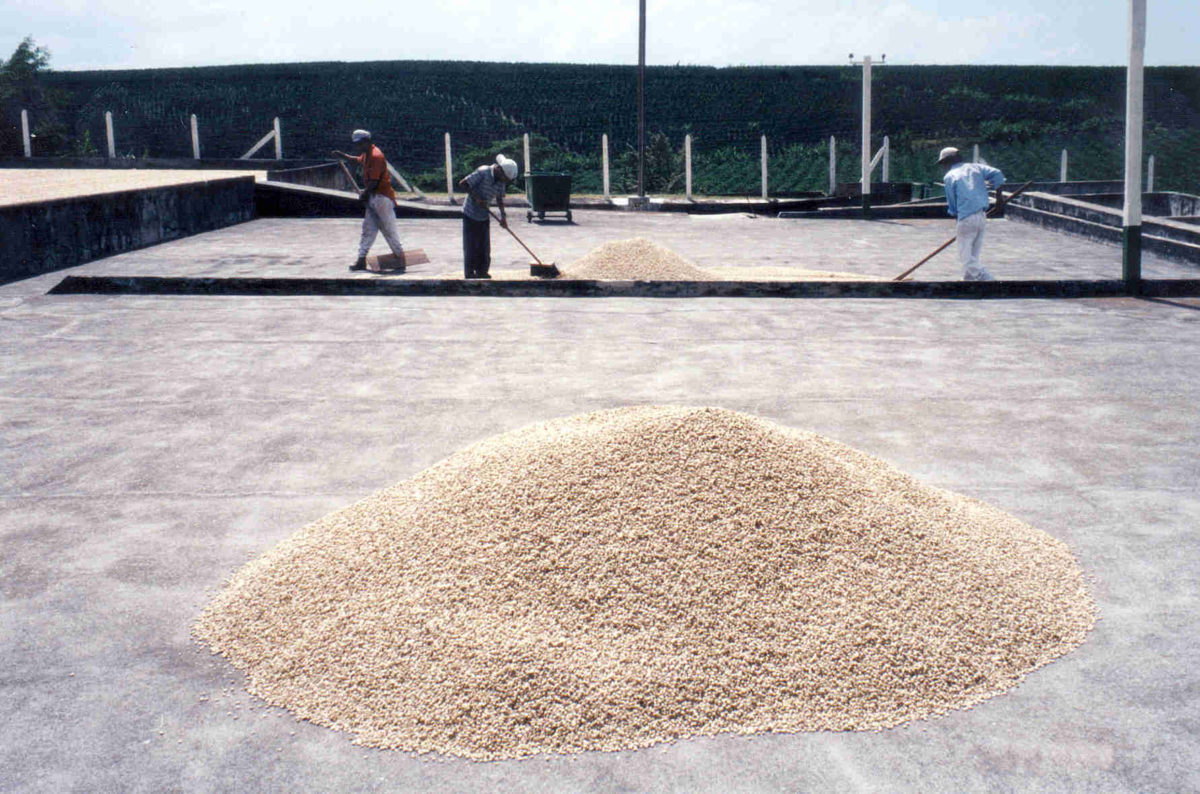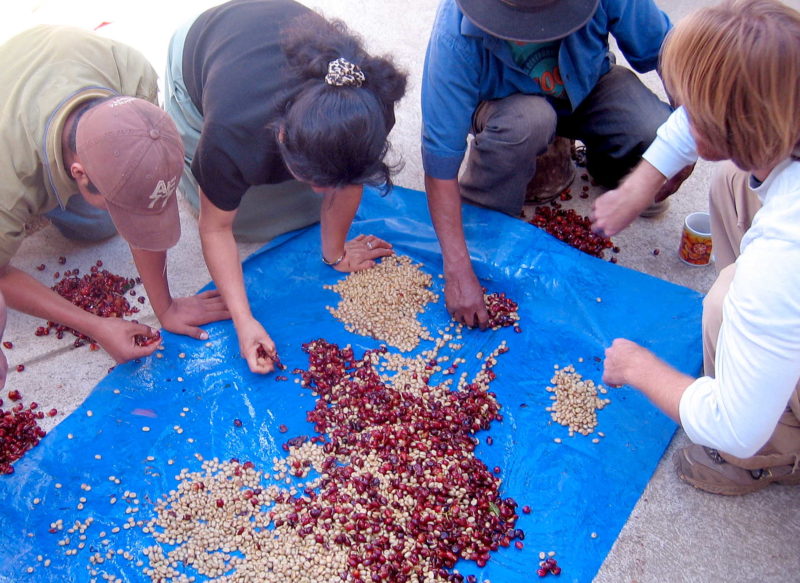Coffee processing stands for the process of removing the pulp from around the coffee bean. Once coffee berries have been cultivated and picked, they are processed. Processing needs to be started at latest 2 days after the berries have been collected to prevent the berries from fermenting. Processing has an immense effect on the flavor of the coffee.

Indian coffee beans being fermented.
Coffee processing methods
The possible methods of processing the berries are wet processed (washed), dry processed (natural) or their intermediate, semi-dry (semi-washed, pulped natural, honey, wet-hulled). These techniques also have multiple variations and names around the world. Processing coffee requires great skills and quality equipment. The differences of various processing methods are introduced below. Even later we talk about the washing stations and drying and sorting coffee.
Washed aka wet process, removes the pulp by a machine (pulping). This enables the bean to keep a small membrane made up of natural sugars around it. This membrane is removed by fermenting the beans in a large water basins. Finally, the coffee is rinsed thoroughly and dried. Washed coffees have a clean mouthfeel and taste.
Natural aka dry process, leaves the coffee berry to dry as it is. The bean is allowed to soak up sugars from the pulp surrounding it. Drying is cheaper than washing, because it doesn’t require large amounts of water. The process requires great care so that the berries don’t ferment. Flavor-wise naturally dried coffees taste very juicy and even jam-like. Their mouthfeel is often heavy.
Semi-washed process removes the pulp the same way as in the wet process. However the membrane is not removed before drying, but rather after, like the naturally dried coffees. This allows the berries to retain a moderate amount of sweetness during the drying process. Flavor-wise semi-dried coffees are between the washed and the dried coffees with a moderately heavy but clean mouthfeel. Pulped natural, honey and wet-hulled processes are all somewhat similar to semi-washed process.
Washing stations

Drying coffee in Costa Rica.
Coffee processing can be done at the coffee farm, if it is big enough to be able to afford personal equipment for it. However, with specialty coffees it is more likely, that the farmers deliver the crop to a separate washing station. Washing stations are often cooperatives formed by local farmers. It is more effective for them to take care of the processing at a shared station than to all do it personally.
Coffees from different farms are usually not mixed together even if they are processed at the same washing station. Each batch is marked as its own micro lot. Often even a single coffee farm can be formed from multiple specific lots.
Many coffees are named after the washing station. This happens often especially if the coffee isn’t named after a specific farm. Often on top of the washing station and farm, the coffee’s name might also include the name of the farmer or area. Sometimes the coffee variety is also mentioned.
Drying and sorting
After coffee processing, coffee beans are dried. The drying of specialty coffees often happens outside on drying-beds. The drying beds are designed in a way, that the beans are spread on a net and air can travel also below the beans. This enables that the coffee dries as evenly as possible. Drying the beans can take approximately 10-20 days. In the case of rain, the beans are covered by shelter.

Coffee quality testing in a farm in Guatemala.
After drying the beans are sorted by size and quality. The bad beans are removed. In many countries, the beans are graded based on their size. For example, in Kenya, AA means that the beans are extremely big. The biggest beans of the crop are usually more expensive, because they have collected the most flavors.
Finally, the coffee is packed into brown burlap sacks and sent to the world. The best coffees from the coffee producing countries are almost exclusively sold abroad, while locals usually settle for the mediocre coffees. The producing of brown burlap sacks is a big employer in many of the countries that produce coffee. That is why the bags that end up at the roasteries are rarely sent back into their origin countries.
ASK MORE BELOW – WE’LL ANSWER TO ALL MESSAGES!
What is Slurp coffee experience?The pictures in the article: CC Abdulla Al Muhairi, CC rohsstreetcafe.
Comments (0)
Leave a reply
You must be logged in to post a comment.
